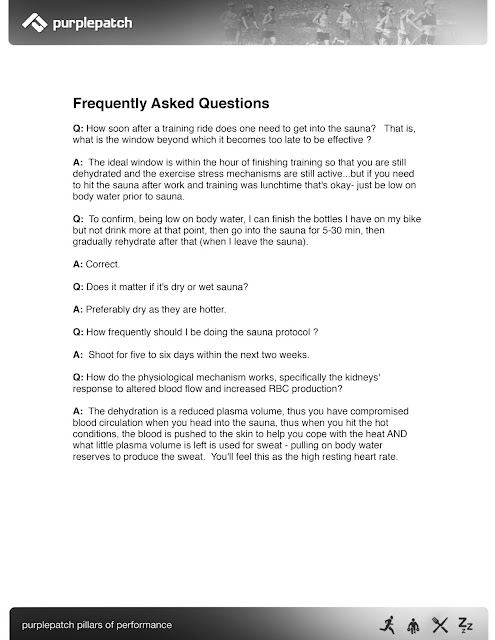For the last few years, I have started racing in Winter & Spring. Since I live in CO, that means I'm usually training in cold temps for races in warm temps. I thought it would be really helpful to save this information in one easy to find spot.
FIRST OF ALL: BE SMART. This information is meant to be used as a tool, but you must listen to your body and your doctor when it comes to heat acclimation. Don't blame me if you decide to be a dumb ass and sit in a sauna for an hour and wonder why you passed out.
One very important point that is not mentioned in any of the articles. (Not that I remember). DO NOT forget sunscreen. Sunburn affects your bodies cooling system. It affects your digestive tract. Nothing good comes from allowing yourself to get sunburned.
Why is heat acclimation or heat training important?
(If you are interested in specific protocol for heat training, scroll down).
This first graphic comes from the Washington Post. If you have a problem reading it, you can click on the previous link.
This is what happens to your body during acclimation.
Ok. GREAT. HOW do I acclimate?
Heat acclimation: Whether you are getting ready to race in a location that is considerably hotter than you live OR you want to get a jump on heat acclimation in the Spring, this video is for you.
When Dr. Patrick published this article in 2014, I had a 70.3 planned in AZ in Oct. That presents a challenge since I live in CO. I followed her advice in this video and spent up to 30 minutes, immediately post exercise. I started with 10 minutes and worked up to 30 minutes in the sauna. I continued this for 2 months prior to my race. When the race came, the temps were in the upper 90's, and I never even felt it. (I should also stress that in addition to the sauna work, Liz set me up with a specific plan to follow the day of the race. Sauna work is only a piece of the puzzle. Make sure you have a race plan in place.)
The video itself might seem a bit technical, but Dr. Patrick does a really good job of summing up each section.
Since the beginning of 2014, new sauna protocols for heat acclimation have come out. I've listed all the articles that I have on heat acclimation.
This article gives you a good guideline on how to start your sauna practice. I want to say that I disagree with the "no drinking" idea. I think that's way too dangerous. When I'm starting heat acclimation, I go for 15 minutes (no water). When I get to 30-45 minutes, I step out and drink at the 20 minute marks.
Another issue that I disagree with is "remain sitting". I sit, and I stand. Standing is considerable harder. I do that for a few minutes at a time and work up to whatever time I feel is good. My thought is that I'm running in the heat, I should mimic that stress as much as possible.
What if I don't have access to a sauna or live in a cooler climate?
This list is not exhaustive, and there are many ways to acclimate.
1.) Sleep in a room that is warmer. (Immediately before a race, make the room cool, so you sleep well.)
2.) Since I've written this post, I no longer have access to a sauna. I have gotten creative in how I train:
a.) I have a workout area at home. When I am heat acclimating, I use space heaters. I start at 75 and work up to the highest setting of the heater.
b.) When I know I will be racing in a hot/humid environment, I add a humidifier to the space heater. Sounds pretty horrible, doesn't it? It is at first, but once I'm acclimated.....I don't notice it.
3.) If you train outside, you can also overdress. (I've never really been a fan of this, but for some people it seems to work).
I can't stress this enough. When you are going through acclimation, you need to make sure that you are drinking and taking in enough electrolytes.
Another sauna protocol:
Again, this is merely a guideline. I don't follow this particular protocol. I base my practice on what Dr. Patrick recommended.
If you scroll down, you'll find links to other articles. Some are a little more reader friendly than others.




